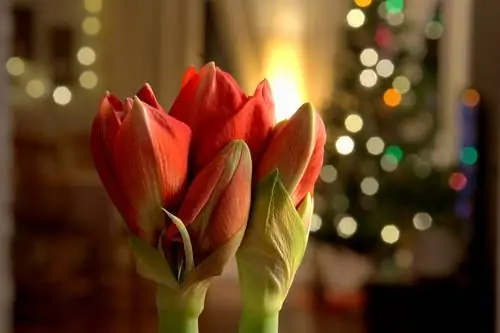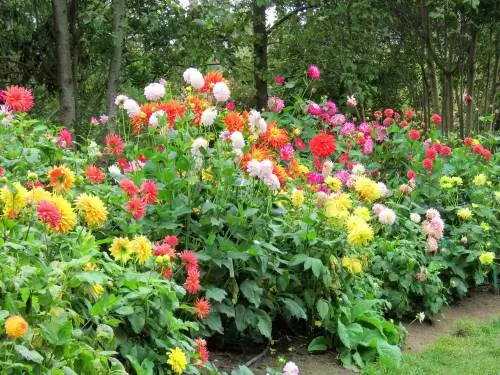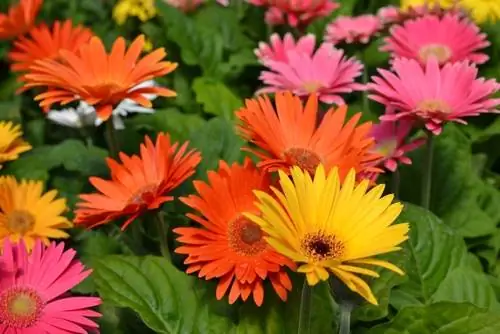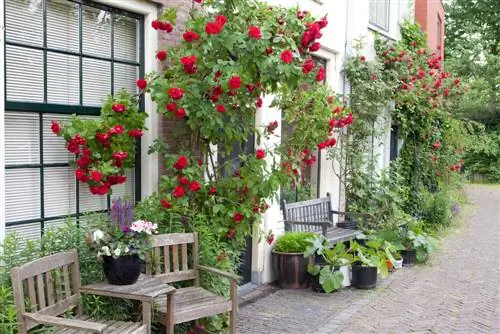- Author admin [email protected].
- Public 2023-12-16 16:46.
- Last modified 2025-01-23 11:22.
In the dark season, the amaryllis with its exotic flowers is a colorful eye-catcher. Depending on how warm the knight's star is, it will beautify the windowsill for about two weeks. Unfortunately, many plants then end up in organic waste, which is a shame because the bulbs will sprout again and again if cared for properly. In the following article we will introduce you to the amaryllis in more detail and give you valuable care tips.

Why is the amaryllis the flower of the month?
The amaryllis, also known as knight's star, is the flower of the month in the dark season. It impresses with its exotic, funnel-shaped flowers in white, pink or bright red. The main flowering period is between November and March and enriches the home during this time.
Plant profile:
- Botanical name: Amaryllis, Hippeastrum
- Order: Asparagales
- Family: Amaryllidaceae
- Genus: Amaryllis
- Growth: Persistent herbaceous onion plant.
- Growth height: 50 to 100 centimeters high.
- Main flowering period: November to March.
- Leaf: Strap-shaped, basal, dark green in color.
- Flowers: Each flower stem has two to four large, horizontally protruding, slightly hanging flowers that can grow up to thirty centimeters in size.
- Flower shape: Exotic looking, funnel-shaped.
- Flower color: From white to pink to strong red. Multicolored flowers possible.
Special features:
The name Amaryllis is the common name for the knight's star. However, the real amaryllis blooms in the summer months. This bulb flower is also known as the belladonna lily and came to our latitudes from southern Africa in the middle of the 18th century.
The knight's stars, which were cultivated on the windowsill in the winter months, were only discovered later in South America and were initially assigned to the genus Amaryllis because of their visual similarity. Since 1987 they have been considered a separate plant genus with around 70 species and over 600 cultivated forms. The attractive plant is still sold under the name Amaryllis.
Origin
The wild species of amaryllis come from Brazil, Bolivia, Paraguay, Uruguay and Argentina. The knight's star is widespread in southern Africa.
Location and care
The amaryllis has three growth phases in which it places very different requirements on the location. The onion sprouts again during the summer months. She then prefers a partially shaded or shady place where the temperature is between 24 and 26 degrees.
In autumn the amaryllis takes a break. It should then be kept constantly cool and darker, for example in the basement. Around 16 degrees is optimal.
The subsequent flowering period falls in the winter months. Unfortunately, the exotic plant withers quickly in warm living rooms. To ensure that the flowers last as long as possible, you should keep the Ritterstern bright and cool. Optimal daytime temperatures are around 20 degrees, which drop to 16 degrees at night.
Once the amaryllis has bloomed, it needs a cold place where the temperature does not fall below ten degrees. The leaves should remain on the bulb until they dry out.
Substrate
Conventional houseplant soil works well. You can mix these with some clay granules, as the amaryllis prefers very well-drained soil.
Watering and fertilizing
You should water the Ritterstern regularly during the growth and flowering phase. It has proven to be a good idea to pour over the coaster. This way the amaryllis can get exactly the amount of water it needs and the pot ball doesn't get too wet.
When the flower begins to wilt, it is fertilized for the first time. Then add commercially available liquid fertilizer (€6.00 on Amazon) to the irrigation water every month. During the main growing period from April, fertilize every 14 days. From August onwards, stop adding fertilizer.
Repotting
Approximately two months before the desired flowering date, place the bulb in a new container if necessary. Alternatively, you can remove the top layer of substrate and replace it with fresh potting soil.
Diseases and pests
The amaryllis is quite resilient. Occasionally, “red burner” occurs, a fungus caused by mite infestation. Unfortunately, there is no cure for this disease. Dispose of affected plants immediately with household waste.
The occasional thrips and mites can be easily controlled with pesticides.
Tip
The knight's star is very poisonous in all parts. The highest concentration is found in the storage tissue of the onions. Therefore, the amaryllis should not be placed within the reach of children or pets.






